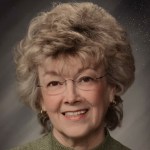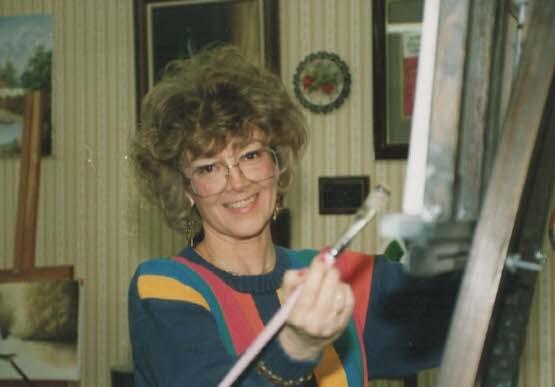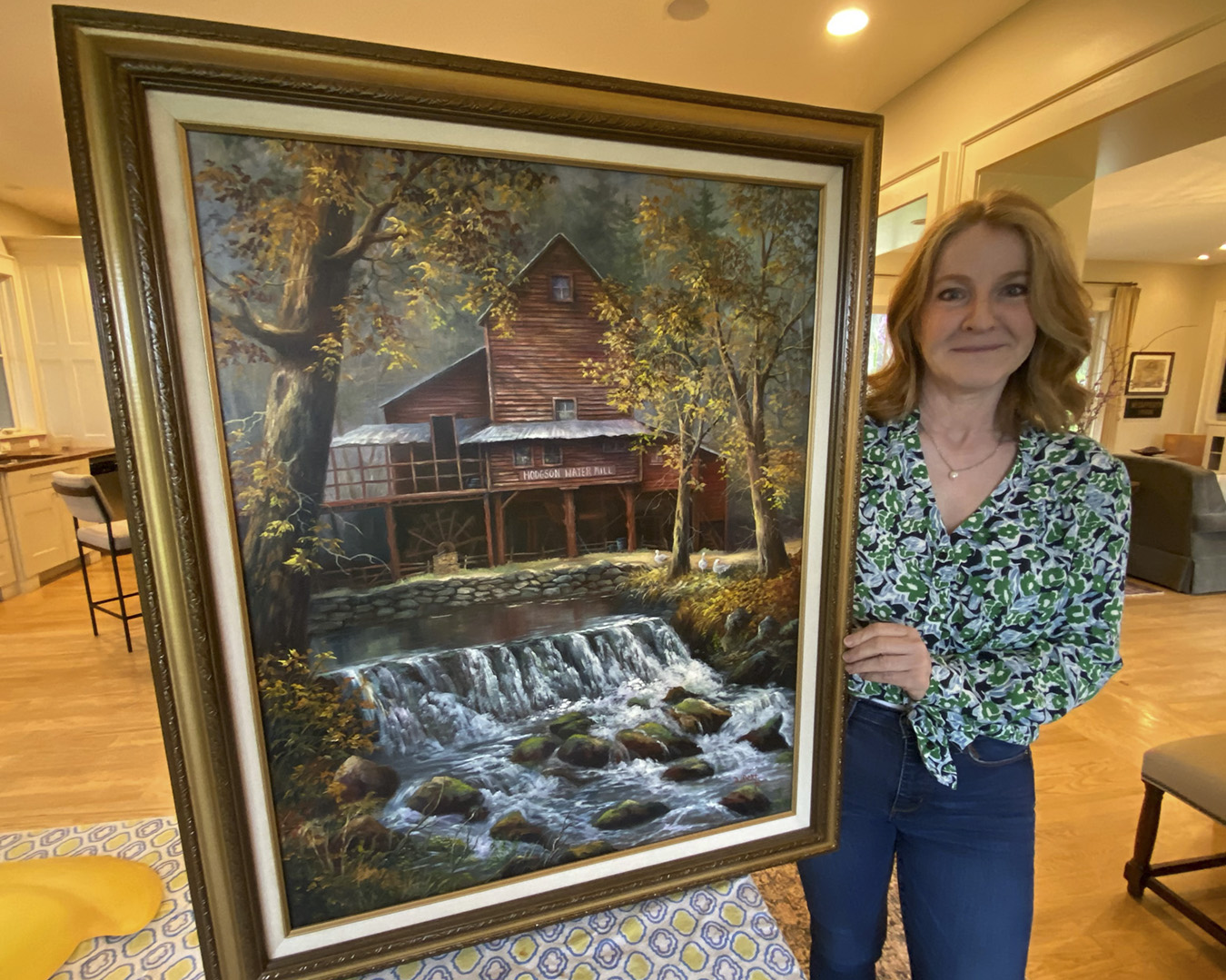From a tiny former gas station in Republic, Dorothy Dent developed a huge publishing operation and a worldwide following as an art teacher.
As word spread of her April 15 death at age 80, accolades from throughout the country and around the planet have poured in via Facebook posts and emails from students and other teachers who learned decorative painting skills from Dorothy during her 40 years of in-person classes, her televised lessons on PBS, or the 40 how-to books she authored and that continue to sell to this day.

Services April 23
A celebration of Dorothy’s life was scheduled for 11 a.m. Saturday, April 23, at Greenlawn South Funeral Home.
View the obituary here.
What initially made Dorothy famous in the craft-art world was a choice of medium: saw blades.
The rural landscapes she created in oils and acrylics were appealing — but the fact that she started painting the scenes on saw blades set her work apart and created a popular new genre: “sawscapes.”
“Oh, my goodness, if you were involved in the decorative art world at all in the 1970s and ‘80s, you could not throw a rock without hitting a painted saw blade — and it was all because of Mom,” says daughter Susie Wieland. “Not just in the Midwest, but everywhere. She did it at just the right time, and it really caught on.”
Dorothy grew up on a farm in what today is southwest Springfield. Her father, Lester McCafferty, was an inventive craftsman when not working the fields, and her mother, Christie, gained local notoriety for growing and decorating gourds. Dorothy began dabbling with a paintbrush early, capturing the rural scenes that surrounded her. In her teens, as she attended Parkview High School, she began studying the work of others, including the late popular local artist Jesse Barnes, watching intently when he put on demonstrations at Battlefield Mall.
“She never actually took formal lessons; she was basically self-taught,” says Susie.
After Dorothy married Charles Dent and set up housekeeping on their own 20 acres on the west edge of Republic, she continued painting for her personal enjoyment. Charles gave her a professional oil painting set he found at a garage sale. Soon, recalls Susie, “Every surface in our house was covered with little painted flowers and mushrooms. She could not find enough surfaces to paint on.”
Dorothy regularly attended local craft shows. After Susie and her older brother, Casey, arrived, they occasionally tagged along.

Inspired by painted saw at show
“At one of the shows someone had a little saw that they’d painted a scene on,” says Susie. “I remember my mom picking that up and saying ‘Hmmm…’ And all of a sudden the blade of every saw we owned had been painted on — barns and snow scenes and such.”
Generically, such artwork is called tole painting, a form of folk art involving decorating household items, especially those made out of tin and other metals. Dorothy’s focus on saw blades, and the subsequent coining of the term “sawscapes,” set her apart and rapidly gained her a following.
“She could not paint enough saws,” recalls Susie as the quaint finished products sold briskly. After their own garage and her father’s and uncle’s workshops were picked clean, finding suitable blades became a challenge. “She and my dad went to garage sales; we lived in the country, and everyone had saws. They’d search for saw blades everywhere. She’d take any saw she could find, but she liked the antique ones the best.”

Neighbors began asking Dorothy to teach them how to tole paint. “The women would come one night a week and paint in our dining room,” says Susie. Dorothy sought out the few teaching manuals that were on the market. However, according to Susie, “Mom said ‘I am going to write an instruction book. I can write a better one.’”
Eventually Dorothy did just that. But first she set up shop in a small building that once housed the office of a gas station at the intersection of Republic’s Main Street and Missouri Highway 174. She dubbed it Painter’s Corner, and enlisted Celia Gabel as her manager.
“Dorothy was the artist; I ran the business,” says Celia. Classes were held in the shop, and Dorothy’s artwork also was available for purchase. “When she started writing books, I typed them all. I was an English major in school, so I also helped with the editing.”
In their 40 years together, Dorothy and Celia self-published 29 instruction books, and 11 more were put out by professional publishers. Tens of thousands have been sold. “Dorothy developed step-by-step methods and techniques to make realistic landscape painting do-able for so many people,” says Celia of the books.
Dorothy began attending larger craft fairs and craft art conventions all around the country. “She would show up with her little 8-by-10-foot booth,” says Susie. “And all day long there would be lines of people to buy her instruction books.”
As her fame grew, Dorothy became a popular instructor at major craft art gatherings nationwide and as far away as Japan and Argentina. “Of course, people eventually got tired of painting on saws,” notes Susie, “and so Mom graduated to painting on canvas and teaching others how to do it.”

A patient and kind instructor
Celia had years of opportunity to observe Dorothy’s teaching: “She was an absolutely fantastic instructor. She was patient and she was kind. She would paint right along with the students.
“When you paint a landscape, you start with the sky. So Dorothy might say, ‘Let’s put in the blues first.’ Then she’d put her brush down and she’d go around and help every student — how to load their brush, how to put that brush on the surface. Then she’d go back and put the clouds on her painting, and go around again, so on and so forth, until the painting was complete.
“If a student got frustrated and said something like ‘Oh, this looks horrible,’ Dorothy would say ‘No, no, it looks really good right there, so let’s see what we can do over here — let’s put in a few highlights and see what happens.’
“With her charm and personality,” says Celia, “she was one of the best instructors there ever was.”
Kitty Gorrell agrees. She met Dorothy about 35 years ago when she enrolled in her classes, and that led to Kitty establishing her own studio in her hometown of Saint Marys, West Virginia.
“Dorothy’s style and her subject matter were just the kind of things that I was interested in, and that my students were interested in,” says Kitty, who credits Dorothy as the model for her own teaching techniques. “Dorothy just had a very quiet demeanor. And when she taught, that calmness came out in her classroom.”
Kitty cites one of the most valuable lessons she learned from Dorothy: “Time control. In teaching classes and seminars, Dorothy always started on time and finished on time. And the students would leave with smiles on their faces and carrying completed paintings — which isn’t all that common in many classes.”
Even Bob Ross came calling
Kitty journeyed to Republic a few times to visit Dorothy over the years, as a student, colleague, friend and houseguest. So did the late Bob Ross, the bushy-haired, folksy painter and instructor who hosted the long-running PBS television series “The Joy of Painting.”
“There was a wholesale art supply distributor called Ozark Art and Craft on East Division Street in Springfield years ago, and Bob Ross came there to teach classes,” recounts Celia. “He came out to our shop several times, and Dorothy had him to her house for supper. One time we all went to Drury (University) to judge an art contest. He was funny and soft-spoken — what you saw on TV was exactly what he was like in-person.
“Bob loved Dorothy’s work, and he asked her to make an appearance on ‘The Joy of Painting.’ So in 1984 she went out to Muncie, Indiana, to his studio and filmed one program, and it was very well-received. So Bob said, ‘What do you think about doing your own series?’ And they decided that Dorothy would do what was called ‘The Joy of Country Painting.’”
Dorothy’s “time control” was vital in producing the two 13-week series that ran on PBS stations. “She only had 26 minutes to complete a painting in each of the shows,” notes Celia, “so she had to work fast.”
Bob Ross episode online; books available
View the the 1984 episode of Bob Ross’ “The Joy of Painting” that featured Dorothy Dent.
Many of her books remain available for purchase at www.dorothydent.com or from online booksellers such as Amazon. Instructional packets and DVDs also are available at the website.
Back in Republic, the Painter’s Corner operation outgrew the original building. It was torn down, along with an adjacent motel, and a larger studio and shop were constructed — twice — over the years. While the business location remained the same, at various times Dorothy’s legal last name quietly changed to Billingsly and Garner. However, throughout she retained Dent as her professional name, and that’s how she continues to be remembered today.
“It didn’t matter where I went,” recalls daughter Susie, “if someone heard my last name was Dent, I can’t tell you how many times I was asked if I was Dorothy Dent’s daughter. We didn’t look that much alike — she was a tiny, tiny person, and by the time I was in the 5th grade I was taller than she was. But she was big in the art world.”
Dorothy also loomed large in the estimation of Susie and her friends as they observed Dorothy’s expanding career and dreamed of their own.
“Almost all my friends had traditional mothers,” explains Susie. “It was the 1970s, and maybe their moms had part-time jobs at a gift shop or something — but most of the time they were home or showing up for their kids’ plays and ball games. One of my girlfriends, who’s an executive in Kansas City, told me: ‘I was always so in awe of your mother because she had a true career.’ And I joked with her and said, ‘Gosh, I was always in awe of your mother because she was always home to make you lunch.’
“Our mother was a great mom. She didn’t hover or fuss over us. But we learned a lot from her, about dealing with people and focusing your energy. She was inspirational in many ways,” adds Susie, who heads her own custom home design business, Wieland Studio, in Springfield, while her brother is an engineer in Kansas City.
“I’ve always been so proud of my mother. Not so much for her paintings — although they are beautiful — but for the fact that once she settled on a goal, something in her said ‘I’m going to do this’ and then she made it happen.”


